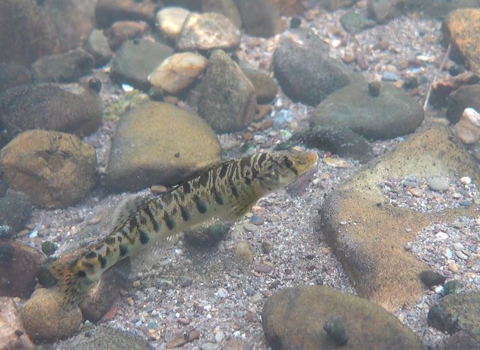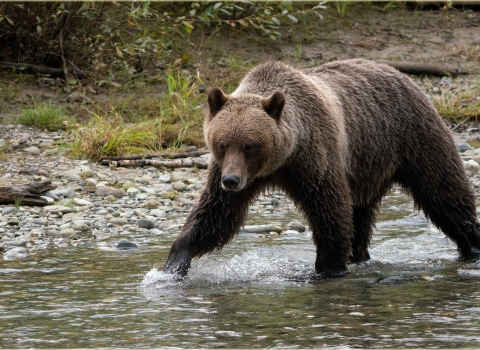Based on a review of the best available science, the U.S. Fish and Wildlife Service has determined that the green floater, a freshwater mussel historically found in 10 states and the District of Columbia, is likely to become endangered within the foreseeable future due to existing and emerging threats. The Service is proposing to list the mussel as threatened under the Endangered Species Act with a simultaneous critical habitat proposal and Section 4(d) rule.
The green floater is still found in seven states within its native range: Maryland, New York, North Carolina, Pennsylvania, Tennessee, Virginia and West Virginia. There are no recent records of green floater from New Jersey or Washington D.C., and it is considered extirpated from Alabama and Georgia and from some rivers in other parts of its range. While the species has strongholds in places, green floaters are rare in nearly 80% of the watersheds where they occur. More than 75% of the nation’s native freshwater mussel species are listed either as endangered or threatened, considered to be of special conservation concern, or presumed extinct.
In watersheds where green floaters are common or even thriving, they face high risks of declines based on current land-use patterns. Development, energy production and agriculture have affected the quality of many streams within the species’ range, and increasing drought, intense storms and rising temperatures associated with climate change climate change
Climate change includes both global warming driven by human-induced emissions of greenhouse gases and the resulting large-scale shifts in weather patterns. Though there have been previous periods of climatic change, since the mid-20th century humans have had an unprecedented impact on Earth's climate system and caused change on a global scale.
Learn more about climate change are projected to further degrade aquatic habitats. As conditions change, green floaters in most places are unlikely to be able to disperse to new habitats that meet their needs: rivers or streams with low to medium flow rates, sand or gravel bottoms, and clean water.
The ESA requires the Service, to the maximum extent prudent and determinable, to designate critical habitat in the U.S. that is essential to the conservation of the green floater. Critical habitat helps focus conservation efforts where they are most needed, particularly for federal agencies, but does not affect land ownership, set aside lands, or establish a park or wildlife refuge.
The Service is proposing to designate approximately 1,600 miles of river in eight units that are currently occupied by green floater as critical habitat in Maryland, New York, North Carolina, Pennsylvania, Virginia, and West Virginia. Two of these units overlap with designated critical habitat for other listed species — including candy darter and Neuse River waterdog — an area totaling 152 river miles.
The areas currently occupied by green floater are considered sufficient to conserve the species, and the Service is not proposing to designate any areas unoccupied by the species as critical habitat. Freshwater mussels like the green floater are important indicators of healthy streams and rivers. At-risk mussel populations are a signal of problems that may also impact fish, wildlife and people. Conserving freshwater mussels and their habitats benefits local communities by protecting water quality for drinking, recreation and other fish and wildlife that all rely on clean, abundant water resources and healthy streams and rivers.
While the U.S. is home to a greater diversity of freshwater mussels than any other country — the green floater is one of about 300 species native to our waters — freshwater mussels have experienced drastic declines over the last century due the loss, fragmentation and degradation of aquatic habitats from interacting stressors, including agricultural runoff, mining wastes, development and dam construction.
Like other freshwater mussels, the green floater will benefit from conservation actions that target aquatic systems, including improved water-quality standards, land protection, river and stream protection and restoration, and riparian riparian
Definition of riparian habitat or riparian areas.
Learn more about riparian -buffer planting projects.
The Service has undertaken proactive work to support conservation of the green floater, including experimentally raising them in captivity to bolster natural populations. Biologists at White Sulphur Springs National Fish Hatchery in West Virginia and Harrison Lake National Fish Hatchery in Virginia have successfully propagated and released juvenile green floaters into Virginia rivers and streams. These efforts have the potential to restore populations of green floater in the future. However, these operations are limited in scope, and long-term population increases in the wild have yet to be documented.
Today’s announcement comes as the ESA turns 50 years old in 2023. Throughout the year, the Department of the Interior will celebrate the ESA's importance in preventing imperiled species' extinction, promoting the recovery of wildlife and conserving the habitats upon which they depend. The ESA has been highly effective and credited with saving 99% of listed species from extinction. Thus far, more than 100 species of plants and animals have been delisted based on recovery or reclassified from endangered to threatened based on improved conservation status, and hundreds more species are stable or improving thanks to the collaborative actions of Tribes, federal agencies, state and local governments, conservation organizations and private citizens.
The proposal to protect the green floater as threatened under the ESA will publish in the Federal Register on July 26, 2023, and public comments will be accepted until September 25, 2023. The Service will evaluate all information received during the comment period and will announce a final decision to list or withdraw the proposal, typically within a year after the proposal.
Comments on the proposal may be submitted through one the following methods:
(1) Electronically: Go to the Federal eRulemaking Portal: http://www.regulations.gov. In the Search box, enter the docket number or RIN for this rulemaking (FWS-R5-ES-2023-0012 or 1018-BF80). For best results, do not copy and paste either number; instead, type the docket number or RIN into the Search box using hyphens. Then, click on the Search button. On the resulting page, in the panel on the left side of the screen, under the Document Type heading, check the Proposed Rule box to locate this document. You may submit a comment by clicking on “Comment.”
(2) By hard copy: Submit by U.S. mail to: Public Comments Processing, Attn: FWS-R5-ES-2023-0012, U.S. Fish and Wildlife Service, MS: PRB/3W, 5275 Leesburg Pike, Falls Church, VA 22041–3803.
Comments should be sent only by the methods described above. All comments will be posted on http://www.regulations.gov. This generally means that any personal information provided will also be posted.


